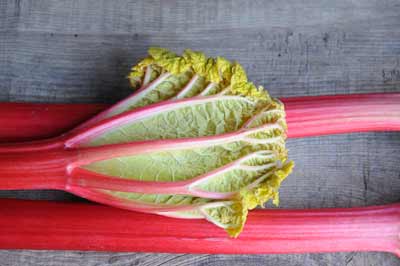Rhbuarb is the pink, large stem of a plant, the leaves of which are poisonous. A native of Siberia, it needs cold weather to thrive. The best rhubarb is forced in a dark place while that which grows outside appears in March and is more robust with a sharper flavour. Plants need two or three years outside to build enough strength to be forced, at which point they can be lifted and moved to dark sheds. At home, we grew rhubarb in a tall chimney pot to keep the sun from it. This results in sweet, pale stems.
The sharper type is good for crumbles, pies and tarts as well as for sorbets, cordials and jams (US: jellies). Traditionally it is felt that the flavour is enhanced by using bananas though it is even better with ugli fruit, pomelo or pomegranate. When cooking, slice quite crudely, add a little sugar and either no water or just a dessert spoon. It will stew down into a tart, sweet mush which is excellent in tarts and pies or as a vegetable alongside rich meats.
Even though the leaves contain oxalic acid they can be used in compost. If you are growing it you will need to remove flowering stems or the plant will be weakened. Rhubarb has laxative properties.
In Britain, an area of Yorkshire, the "rhubarb triangle" between Pontefract, Leeds and Wakefield, is where rhubarb is famously forced in unlit sheds and harvested by torchlight or even candlelight. It is said that, in these conditions, the rhubarb grows so fast that, standing in the dark, you can hear the whispering and sticky cracking noises of the stems bursting forth. Traditional varieties such as Timperley Early and Stockbridge Harbinger are sometimes used. Until the 1950's these were sent to London by a train known as the 'Pink express'. It is worth seeking out this very superior rhubarb.
